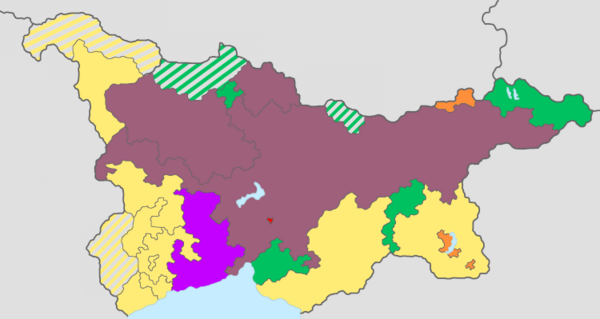Mossyna
Mossyn Federation | |
|---|---|
|
Flag | |
| Capital | Kvirike |
| Demonym(s) | Mossyn |
| Government | Federal presidential republic |
| Ramazi Iosava | |
| Ghiurge Annoli | |
| Ruslan Shapun | |
| Population | |
• 2016 census | 26,554,754 |
| GDP (PPP) | estimate |
• Total | $304 billion |
• Per capita | $11,481 |
| Gini (2015) | 36.5 medium |
| HDI (2015) | .780 high |
| Date format | mm-dd-yyyy AD |
| Driving side | right |
Mossyna (Moschian: მოსინა, tr. Mosina), officially the Mossyn Federation (Moschian: მოსინიკები ფედერაცია, tr. Mosinik’ebi Pederatsia), is a mountainous country in Western Euclea.
Etymology
History
Politics
Governance
Mossyna is a federal democratic presidential republic, with the President as the head of state and government. The executive branch of power is made up of the President and the Cabinet of Mossyna. The Cabinet is composed of ministers appointed by the President and confirmed by the Supreme Assembly. Ramazi Iosava is the current President of Mossyna after winning 51.4% of the vote in the 2018 election. The president is elected by popular vote for a four-year term, with no term limits.
Legislative authority is vested in the Federal Parliament of Mossyna. The bicameral Federal Senate of Mossyna, made up of the Supreme Assembly and the Federation Council, adopts federal law, declares war, approves treaties, has the power of the purse and the power of impeachment of the President. The members of the Supreme Assembly, known as deputies, number around 200 of whom 100 are elected by plurality to represent single-member districts, and 100 are chosen to represent parties by proportional representation. Those of the Federation Council, known as Senators, are appointed by their state, which send 8 for a total of 60 altogether, and are expected to be politically independent of any party.
Mossyna has a rich multi-party system, though the majority of its federal parties, and many state parties, belong to one of two coalitions: the broadly conservative and pro-Marolevia Pan-Red Coalition, and the broadly liberal and pro-Euclean Community Pan-White coalition. The Presidential elections of 2018 resulted in a victory for the Whites, placing the executive in opposition to the Red-controlled Supreme Assembly. The political system in a state of transition, with frequent adjustments to the balance of power between the President and Parliament, and between the Federal government and the States. Observers note the deficit of trust in relations between the two coalitions, and the instability in the system this causes.
Foreign Relations
Military
Political divisions
Federal subjects According to the Constitution, the country comprises twenty federal subjects, including the disputed republics of Askana and Chemeria, and the disputed districts of Ureki and Bakhmaro. These subjects have equal representation—two delegates each—in the Federation Council. However, they differ in the degree of autonomy they enjoy.
- 8 republics: nominally autonomous; each is tasked with drafting its own constitution, direct-elected head of republic or a similar post, and assembly. Republics are allowed to establish their own official language alongside Moschian but are represented by the federal government in international affairs. Republics are meant to be home to specific ethnic minorities.
- 2 federative republics: similar to republics, with the key difference being that they are federal themselves, acting as microcosms of the larger federation.
- 2 autonomous regions: essentially the same as republics. Their designation is due to their population being considered too low for republic status, but in need of separate representation at the federal level.
- 1 special region (the Khym Shamkhalate): unique in that it is the only direct federal subject to possess an unelected head of state, the Shamkhal
- 6 districts: similar to states in other federal nations, with locally elected governors and legislatures
- 1 capital region (Kvirike): the capital of the Federation which functions as separate region.




